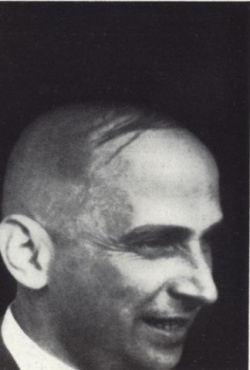Difference between revisions of "Ernő Kállai"
| Line 1: | Line 1: | ||
| − | + | {{Infobox artist | |
| + | |image = Ernst_Kallai.jpg | ||
| + | |imagesize = 250px | ||
| + | |birth_date = {{birth date|1890|11|9|mf=y}} | ||
| + | |birth_place = Szakálháza, Austria-Hungary (today Hungary) | ||
| + | |death_date = {{Death date and age|1954|11|28|1890|11|9|mf=y}} | ||
| + | |death_place = Budapest, Hungary | ||
| + | }} | ||
| + | Theorist, aesthetician, and teacher. Kállai studied Hungarian and German, as well as Literature and History, at the State Civic Teacher Seminar in Budapest between 1910 and 1913. Starting in 1920, he worked as a journalist in Germany. Among other publications, this included many art and culture magazines (such as ''Ararat'', ''Weltbühne'' and ''Cicerone''). [http://bauhaus-online.de/en/atlas/personen/ernst-kallai] | ||
| + | Kállai had gained a reputation with his reviews, published in ''Das Kunstblatt'' and ''Sozialistische Monatshefte''. In the early 1920s, he defended Constructivism, but from 1925 onward, the decline of revolutionary utopias made him turn to craftmenship and realism. At the beginning of the economic crisis, when left-wing political movements grew in strength, Kállai focused on social aspects of housing and the function of painting, film, photography, etc. He advocated the notion that production had to meet the real needs of the masses. During his year as editor of the ''Bauhaus'' journal (1928-29), he declared - both in his teaching and in many of his articles - that the Bauhaus was scientifically oriented, in accordance with the principles of its new director, [[Hannes Meyer]]. | ||
| + | |||
| + | Because he was no longer allowed to publish after 1933, he returned to Budapest in 1935 and taught aesthetics and art history at the Hungarian Applied Arts and Crafts School starting in 1946. In 1948, he became a member the European School artist group, founded the Gallery of the Four Directions and became the director of the Section for Fine Arts in the Art Council of the Hungarian government. During the last years of his life, Kállai increasing retreated from the public offices due to the changed political situation and translated Hungarian fiction books into German. [http://bauhaus-online.de/en/atlas/personen/ernst-kallai] | ||
| + | |||
| + | * [http://bauhaus-online.de/en/atlas/personen/ernst-kallai Kállai at Bauhaus-Online.de] | ||
| + | * [http://artportal.hu/lexikon/muveszettorteneszek/kallai-erno Kállai at Artportal.hu] (in Hungarian) | ||
* [http://hu.wikipedia.org/wiki/Kállai_Ernő_(művészeti_író) Kállai at Hungarian Wikipedia] | * [http://hu.wikipedia.org/wiki/Kállai_Ernő_(művészeti_író) Kállai at Hungarian Wikipedia] | ||
Revision as of 10:32, 25 January 2014
 | |
| Born |
November 9, 1890 Szakálháza, Austria-Hungary (today Hungary) |
|---|---|
| Died |
November 28, 1954 (aged 64) Budapest, Hungary |
Theorist, aesthetician, and teacher. Kállai studied Hungarian and German, as well as Literature and History, at the State Civic Teacher Seminar in Budapest between 1910 and 1913. Starting in 1920, he worked as a journalist in Germany. Among other publications, this included many art and culture magazines (such as Ararat, Weltbühne and Cicerone). [1]
Kállai had gained a reputation with his reviews, published in Das Kunstblatt and Sozialistische Monatshefte. In the early 1920s, he defended Constructivism, but from 1925 onward, the decline of revolutionary utopias made him turn to craftmenship and realism. At the beginning of the economic crisis, when left-wing political movements grew in strength, Kállai focused on social aspects of housing and the function of painting, film, photography, etc. He advocated the notion that production had to meet the real needs of the masses. During his year as editor of the Bauhaus journal (1928-29), he declared - both in his teaching and in many of his articles - that the Bauhaus was scientifically oriented, in accordance with the principles of its new director, Hannes Meyer.
Because he was no longer allowed to publish after 1933, he returned to Budapest in 1935 and taught aesthetics and art history at the Hungarian Applied Arts and Crafts School starting in 1946. In 1948, he became a member the European School artist group, founded the Gallery of the Four Directions and became the director of the Section for Fine Arts in the Art Council of the Hungarian government. During the last years of his life, Kállai increasing retreated from the public offices due to the changed political situation and translated Hungarian fiction books into German. [2]